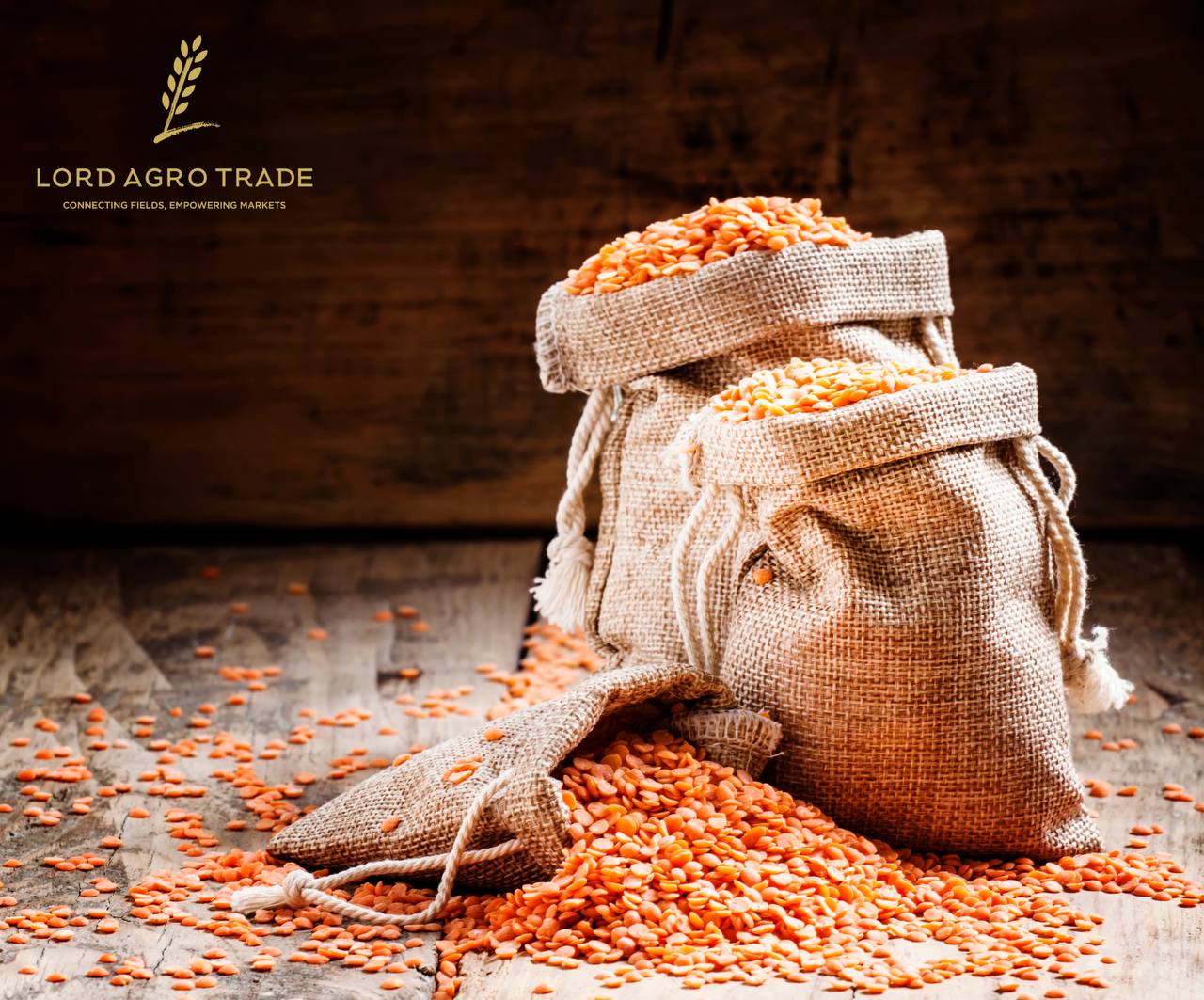Gulfood
17 To 21 FEB 2025 | DUBAI WORLD TRADE CENTRE
We’re excited to see you at Gulfood 2025!
Gulfood
17 To 21 FEB 2025 | DUBAI WORLD TRADE CENTRE
We’re excited to see you at Gulfood 2025!


lentil exports In 2024, is presently in recovery, having turned around after a few tough years. Several issues, such as the better conditions for growing plant food, the changes in trade regulations, and the growing demands in the global plant protein market are the driving forces behind this rapid growth occurrence. Lentils, a main food crop in countries like Canada, India, and Turkey, are very important due to their great nutrition.
In the past few years, the lentil industry was severely hit by the disruptions. The changing climate, supply chain problems, and trade conflicts, along with the COVID-19 pandemic, lowered the time of shipping the product. But, until 2024, the favorable weather patterns in the dominant growing zones led to better yields, thereby, the supply got balance
On top of that, the increase in demand for vegan and vegetarian diets has also propelled the lentil trade and lentil exports. As more consumers follow a vegetarian or vegan diet, lentils have become so popular because they are a high-protein source and also have a low environmental impact.
The trend in the lentil exports of 2024 has been a representation of global agricultural trade moving toward a better direction. Even though some difficulties, including the weather uncertainties and the changing market conditions, still exist, the lentil for the lentil market looks good.

Although the world lentil market is growing, Canada still takes the leading position as the largest producer of this crop. The 2024 Canadian lentil harvest, having weathered climate tribulations of the previous years, has after all been reviving. The period of 2010-2019 saw Canada produce an annual lentil average of around 2.2 million tons, which was 40% of the global supply.
Due to the drought that hit in 2021, production was unfortunately lower, but the situation improved by 2024. By then, with the bigger part of the technology products and the return of favorable weather – the year 2021 was pretty harsh – the production has managed to increase again. The main production center of lentils in Canada still is the province of Saskatchewan with a share of 90%, while the rest of the lentil is produced in Alberta and Manitoba.
Besides being the top producer, Canada is also the largest lentil exporter with over 60% of global exports involving it in the year 2024. The total value of Canada’s lentil exports in 2020 reached $2.6 million, having India, the European Union, and Turkey as the main markets. As the largest lentil consumer in the world, India is the number one market for the lentils imported from Canada. After the 2018 and 2019 domestic production surge, the Indian embargo on imports has come into existence. Nevertheless, by 2024, most of the restrictions have been lifted, and import duties have also been decreased, making Canadian exports more competitive.

The first major thing we learned was the specifics of the announcement, specifically India’s steady reduction in lentil import tariffs which had begun back in 2020 thereby encouraging the two major importing countries Canada and Australia. Moreover, it was found out that Turkey was the second-largest lentil importer and Canada was the only supplier of about 80% of Turkey’s requirement. (Exports/exhibits respectively.) The weather, which was not conducive to lentil production in 2021, and real-time delivery were the problems there and then, but these issues have been overcome so that by 2024, Canada’s lentil exports have increased in global markets.
Canada’s lentil exports are on track to surge further in 2024, as the prices in markets like India are getting lower and the worldwide need for vegetable-protein-based food continues to grow, thus the country can forever increase their profits.
Australia has been growing lentils at a good rate, with documented production reaching about 950,000 tons in 2024. Compared to prior years, this is a significant increase. Furthermore, Australia now exports $420 million worth of lentils due to the continuous increase in global demand.
Australia is still in second place as a lentil exporter globally providing over 14 percent of the total lentil exports in the world.
The main export markets of Australia are still Bangladesh (35 percent), India (20 percent), and Sri Lanka (18 percent), which are the three major countries that make up over three-quarters of lentil shipments from Australia. In 2024, Australia’s market shares in Bangladesh have increased to 55 percent, where the exports have grown from $134 million in 2020 to about $160 million in 2024.
Australia’s lentil exports have increased by 25% as of June of this year. More specifically, this was mostly due to higher exports to emerging countries like Egypt and Sri Lanka, which compensated for lower exports to India. The surge in domestic production and the modifications to India’s trade regulations have had an impact on the country’s exports of lentils. Nonetheless, Australian businesses have been able to overcome the effects of this slump by shifting their attention from India to Egypt and beginning exports there.

As of 2024, the global lentil trade is strongly chained to India’s economic policies alongside the production conditions, as this country is the main lender of the world when it comes to lentils. Lentil imports were also an undeniable thing for India in previous years due to bad weather conditions. On the other hand, with favorable weather conditions, India has been able to produce more lentils, and the government has also restored the import restrictions policy, which is aimed at helping local farmers, in recent years.
Consequent to this, however, India, being one of the leading consumers of plant-based proteins, still has to depend on imports for the fulfillment of its demand since the local production is not always enough. In the production of lentils in India in 2020, only about 1.1 million tons were produced while with the agricultural conditions now, it is expected that this figure will increase to 1.3 million tons by 2024. Nevertheless, the usage of lentils in India is still much higher than the production.
In 2024, India utilizes all sorts of tools in order to manage its local lentil market. Government support policies, which guarantee the purchase of agricultural products, and import restrictions are the main instruments that the Indian government regulates the market with. Although import tariffs were decreased in 2020, with the result that they were negligible by the middle of 2021, in 2024 the authorities have re-imposed some tariffs in order to ensure the growth of the domestic industry.
Higher imports have been witnessed from Canada and Australia because of increased demand and reduced tariffs in some countries in 2024. By 2024, while Canada and Australia account for 75% and 15% of the total lentil imports that India brings in, the US has a smaller share of around 3%. Even though U.S. lentils face higher tariffs, Canada and Australia enjoy the benefits of lower tariffs (around 10%), thus they are able to seize a larger portion of the Indian market. Lentil imports to India in the first half of 2024 have registered a considerable growth compared to previous years, which is expected to continue for the rest of the year.
Final word
We analyzed different dimensions of the lentil market and investigated the global lentil exports recovery in 2024. Such a rebound was supported mostly by favorable weather conditions, a greater worldwide demand for plant-based proteins, and some changes in trade policies.
Canada, which is the world’s leading producer of lentils, has been able to recover lost production and exports after simplified issues in the past. In 2024, Canada using the latest agricultural practices and favorable weather will still be one of the key players in the lentil market supplying regions like India, the EU, and Turkey. The steadily rising demand in India and the newly reduced levies of import tariffs have been the causes of more lentil exports from Canada and Australia.
The land down under, which is the second largest lentil exporter, has also been a witness to an impressive production and export performance boost. In 2024, lentil exports from Australia were worth $420 million, with Bangladesh, India, and Sri Lanka being the major markets. Even though exports to India have decreased due to changes in local production and import policies, Australia has filled the gap by increasing its exports to other markets like Egypt and Sri Lanka.